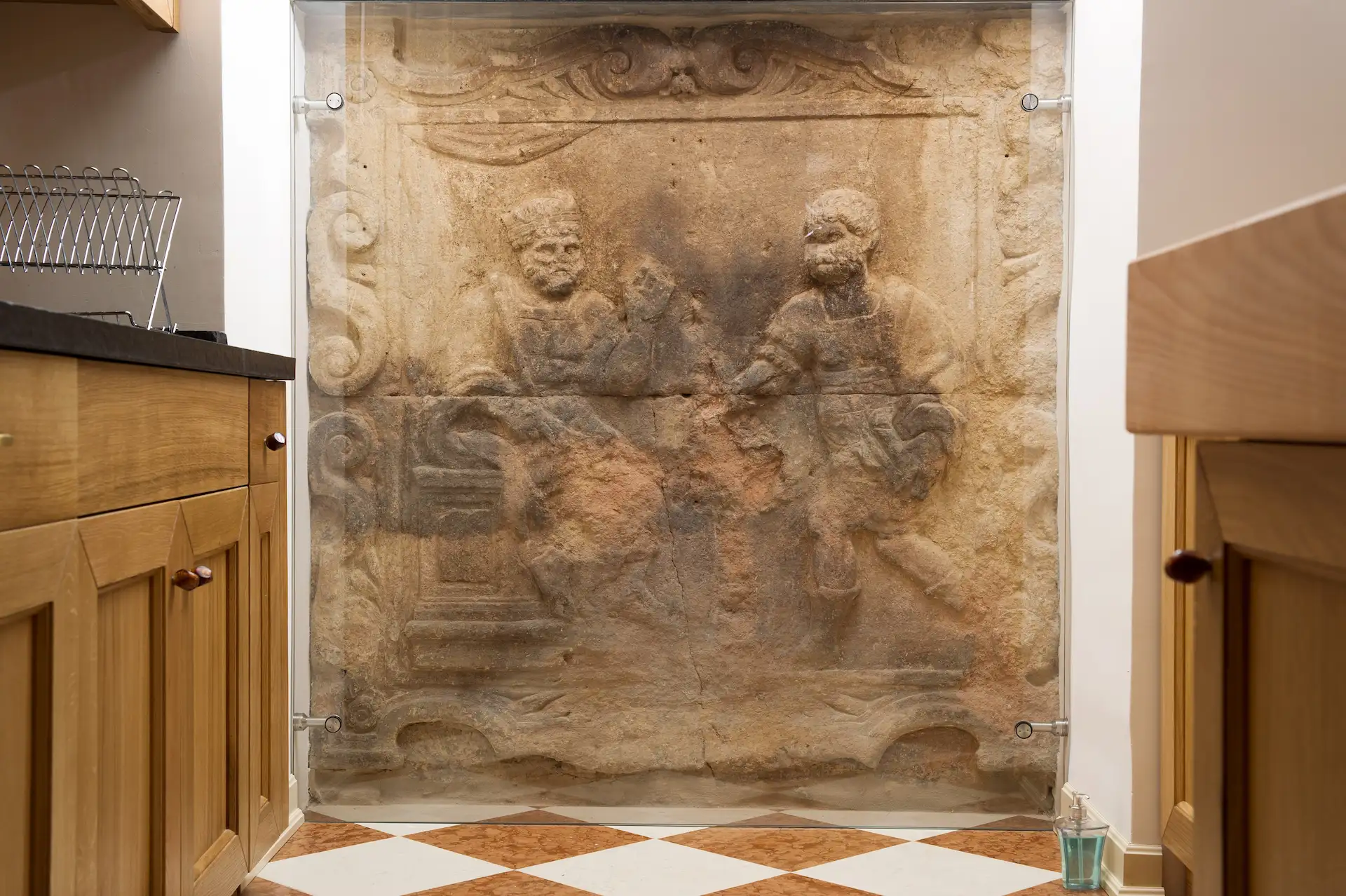Renting a palazzo in Venice is not only a luxurious way to spend time in the world's most intriguing city, it is an opportunity to walk the same floors as some of history's most commanding individuals. Venice is like an ongoing theatrical production, a show that has been running for more than a thousand years. The set remains almost the same, as do many of the characters -- aristocrats and gondoliers, artist and musicians, shopkeepers and fishmongers, saints and sinners -- each playing their appropriate role. Great minds built Venice, and their thoughts pervade the air. Memories linger on silk wall coverings and dangle from Ca' Rezzonico chandeliers. Footsteps from centuries ago have left their imprint on the pebbled Venetian pavimento. Every living space comes with dynamic stories you can step into, or create yourself.
More than 200 years ago, Francesco Guardi painted the View of the Palazzo Loredan dell'Ambasciatore on the Grand Canal, preserving the majestic 15th-century Gothic palace with oil and canvas for humanity to enjoy. The painting is now in the Amgueddfa Cymru - National Museum Wales in Cardiff, accepted in 2010 under a program which enables taxpayers to transfer works of art, archives and manuscripts, and important heritage objects into public ownership instead of paying an inheritance tax. The name of the previous owner was not revealed so we don't know how a Welshman (or woman) came to possess what appears to be a specifically-commissioned Venetian painting, but the decision to release the work of art so everyone's eyes can see it was an interesting choice.

The actual Palazzo Loredan dell'Ambasciatore that still stands today in its impressive location on the Grand Canal was built in the late 1400s during the Imperial Age of Venice by the noble Loredan family, and is a fine example of Venetian Gothic architecture. Birthplace of two Doges, the palace was called "dell'ambasciatore" because it later became the home of the ambassadors of the Austrian Empire to the Venetian Republic.
At the time the palace was built, the Venetian Republic was at the height of its power, and known as the "Queen of the Mediterranean." Palaces were not only homes, but business headquarters for Venetian nobility, the merchants and traders who made up the ruling class. Venetian palaces were designed to impress, and were considered icons that represented Venice's cultural, commercial and political superiority. As the center of much of the world's wealth and culture, Venice thought of itself as the "New Rome" -- an attitude that Pope Julius II and the rest of Europe tried to crush with the League of Cambrai in 1509.
Centuries later, in 1716, one Loredan ancestor, Antonio, was the administrator of Corfu who defeated the Turks, together with Count Johann Matthias von der Schulenburg, a Saxon general. After the battle, Count Schulenburg moved to Venice and set up house inside the Loredan Palace, along with twenty-five members of his entourage and four gondoliers, and was known for his impressive art collection and illustrious dinner parties.
In 1752, another ancestor, Francesco Loredan, the Doge of Venice, offered the palazzo as a residence for the Ambassador of the Holy Roman Empire in exchange for twenty-nine years of restorations. The first Imperial Ambassador to live there was Count Philip Joseph Orsini-Rosenberg, who, in his vintage years, married the dynamic Giustiniana Wynne, whose passionate love affair with the Venetian nobleman Andrea Memmo was immortalized in the book, A Venetian Affair, by Andrea di Robilant, Memmo's great, great, great, great, great grandson. Required reading before coming to Venice, A Venetian Affair is based on a stash of clandestine correspondence that di Robilant's father found in the attic of his palazzo. The book fills in details of the love affair documented centuries before in the memoirs of Giacomo Casanova, a close friend of the couple, and offers insight into Venetian life at the time of the decline of the Republic.
In 1749, Genoese Count Giacomo Durazzo became ambassador to the court in Vienna where he was appointed director of the imperial theaters in 1754, initiating a major reform of both opera and ballet. After gaining a reputation for amorous relations with beautiful ballerinas and actresses, he was forced to resign in 1764, and next appointed imperial ambassador to Venice, moving into Palazzo Loredan dell'Ambasciatore with his wife, Ernestine, maid of honor and lady of the bedchamber to Empress Maria Theresa. When the young Wolfgang Mozart and his father passed through Venice in March, 1771, Count Durazzo, who knew the Mozarts from Vienna, had them over to dinner and arranged a concert of Wolfgang's music. Centuries later, it would come to light that Count Durazzo was the first to get his hands on the Antonio Vivaldi scores published by Estienne Roger, which then disappeared for nearly 200 years, only to be rediscovered in 1926 in a boarding school in Piedmont run by Salesian Fathers. Count Durazzo was also responsible for creating the Albertina Museum in Vienna, together with Duke Albert of Saxen-Teschen. It would not be surprising to learn that it was the same Count Durazzo who had commissioned Francesco Guardi to paint the View of the Palazzo Loredan dell'Ambasciatore on the Grand Canal around 1780.

These days, the Palazzo Loredan dell'Ambasciatore is owned by the Gaggia family, who have restored the palace to contemporary standards while retaining its ancient charm. The palazzo was a wedding gift from Achille Gaggia to his daughter in the 1930s. Achille Gaggia, an engineer, together with Vittorio Cini and Giusseppe Volpi, "the Venetian group," created one of the world's premiere electrical companies, Italy's Società Adriatica di Elettricità, or SADE, nowadays called ENEL, and went on to transform the Veneto region and beyond into an industrial power with the use of hydroelectricity. The group expanded into other areas of interest, one of which was CIGA (Compagnia Italiana Grandi Alberghi, or Italian Grand Hotels Company), which focused on luxury hotels and tourism.
Achille Gaggia's great-grandson, Filippo, is one of the owners of Views on Venice, one of the most prestigious short-term rental agencies in town. Luxury tourism is the area that the personable Filippo Gaggia has decided to concentrate on himself. Growing up inside Palazzo Loredan dell'Ambasciatore, well-connected and with an address book full of trusted connections, Filippo founded his new brand, the VOV Collection, to focus on palazzi rental, starting with his family's property, where he still lives today. Charming, inventive, and with a deep love for his city, Filippo has restored Palazzo Loredan dell'Ambasciatore to its rightful glory and opened it up to visitors.
The Piano Nobile della Loggia, the "second" piano nobile where Filippo's grandmother used to entertain, features a spectacular Rezzonico chandelier suspended from the high ceiling above a Steinway grand piano in the reception salon. The dining room is the same that has hosted the world's elite for centuries, and the outdoor terrace boasts dramatic views of the Grand Canal. The Loggia has three double bedrooms, each with en-suite bathroom, three living areas, a dining room on the Grand Canal, and a full contemporary kitchen. Up a flight of stairs on the mezzanine level are four smaller bedrooms (two double and two single) with two bathrooms and a staff/laundry room. In addition, there is a LCD flat screen TV, Bang and Oluffsen sound system, wireless broadband connection and satellite TV, as well as air conditioning in all the bedrooms with the exception of one single. The Loggia sleeps twelve, and is considered one of the most exquisite properties to rent in Venice.
-Piano-Nobile-della-Loggia.webp)
The Piano Nobile degli Scudi is on the first "noble" floor, and was recently refurbished by master craftsmen. An impressive accommodation for up to nine guests, it is furnished with exquisite family antiques cleverly integrated with contemporary designers -- the lush Fortuny fabrics, Zoffany and Brunschwig wallpapers and Farrow & Ball paints compliment the sofas especially crafted by Florentine artisans. In addition to the formal reception salon, there are two sitting rooms, a formal dining room, a breakfast room and three handsomely-decorated en-suite double bedrooms and an en-suite twin, as well as an additional bathroom. Upstairs on the mezzanine level is a simply furnished self-contained suite and laundry room.The deluxe contemporary kitchen revealed a surprise during the recent renovation: the remains of an original 15-century fireplace that had been hidden for centuries. Sprinkled throughout the apartment are personal touches like handmade Venetian beaded flowers, family photos -- even Filippo's mother's silver salt and pepper collection -- making Piano Nobile degli Scudi feel like a real home.
Both Piano Nobili are accessible by lift, and offer impeccable style, stellar service and a water entrance for quick and easy trips by boat taxi. The multi-lingual VOV Collection concierge will tend to your every need with a smile. Palazzo Loredan dell'Ambasciatore boasts a secluded private garden and five additional apartments of simpler style which, when taken with the Palazzo’s two Piano Nobile apartments, provide exceptional accommodation for up to 40 guests.


